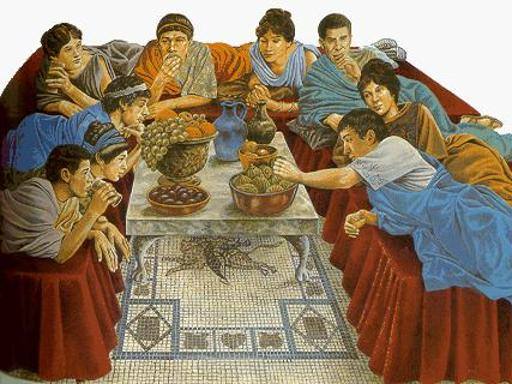What did the ancient Romans eat?
What did the ancient Romans eat? Other times, gastronomic habits have definitely changed: this is why it is not obvious to ask what the Romans ate two thousand years ago. Something remained, habits included, of course…
…but the differences, even for the subsequent grafts of new foods and ingredients (which arrived centuries later from the Americas or Asia) are substantial. Let’s see what were the favorite dishes in republican and imperial Rome.

Rome and in Roman-influenced circles, three meals a day were eaten: jentaculum, prandium and coena.
What we know today comes mainly from the recipe book of Apicius, a well-known gastronome of the imperial age, who wrote the “De re coquinaria”, from here we can draw the greatest knowledge on ancient Roman cuisine.
Breakfast, called jentaculum: we drank milk, and ate bread, cheese, honey, dried fruit or even the leftovers from the night before. It was consumed very quickly and the young people ate adipata (pastries) before going to school.
In the late morning there was another quick snack based on fish, bread, fruit, legumes and wine called prandium. It roughly corresponded to our lunch.

The important meal, on the other hand, took place in the late afternoon and was the coena, in which meat was often the main dish.
The main ingredient of Roman cuisine was the “garum” a sort of very refined, expensive and difficult to find brine. Pepper, cumin and ligustico were the most used spices and the “main dishes” were based on meat, mainly pork.
A peculiar feature of ancient Roman cuisine was the combination of contrasting flavors: sweet with spicy, sweet with salty or sweet with spicy. Special tastes and flavors: who knows if the recipes of the famous chef Apicius would be so successful in our days. For the Romans of the time they were very refined and appetizing.

Most of the population, who were not rich, ate much simpler meals. The people ate mainly dishes based on cereals, legumes and fruit, with little meat and certainly could not afford to have dinner in the “tricliniums”, nor lying on comfortable beds / sofas, as did rich and patricians, many of whom protracted their dinners even until dawn, with large consumption of wine. The disadvantage was that of eating less, with less energy, vitamins and proteins. The advantage, on the other hand, was to eat, probably, in a healthier way without the use of condiments such as “garum” and without the excessive consumption of meat that often caused gout disease in the rich.

The most popular meats by the Romans were suckling pig, lamb, kid, chicken, donkey, wild boar, pheasant, peacock and, incredible but true, the dormouse. The game was aged and spiced. The meats were overcooked, to make them very soft. The first times in milk. Fresh fish was for the rich, dried and preserved fish for the people.
As mentioned often the flavors were sweet and sour, which is why honey was often used to mix.
Mushrooms with honey, pigeon meat with dates and marinated peaches are very popular.
Conviviality was of great importance: the banquet often had religious and sacred implications.
